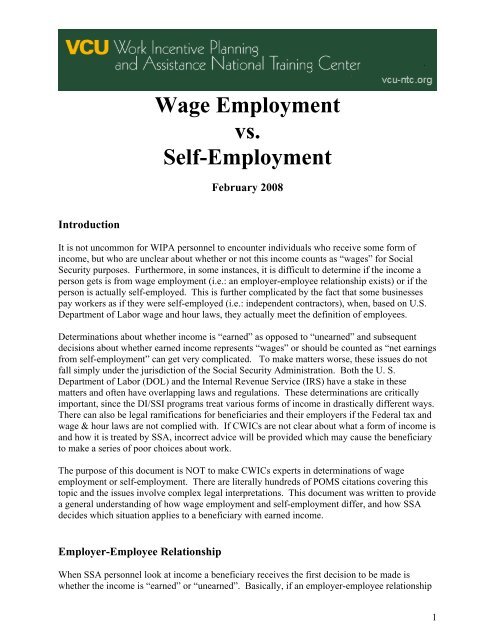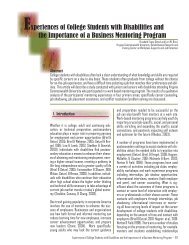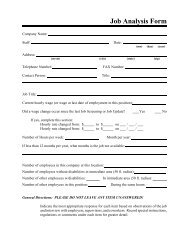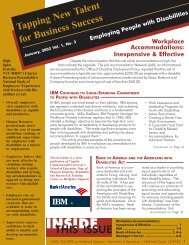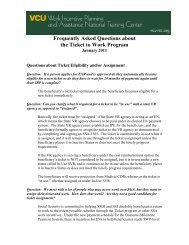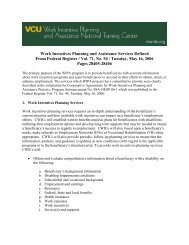Wage Employment vs. Self-Employment - Worksupport.com
Wage Employment vs. Self-Employment - Worksupport.com
Wage Employment vs. Self-Employment - Worksupport.com
You also want an ePaper? Increase the reach of your titles
YUMPU automatically turns print PDFs into web optimized ePapers that Google loves.
<strong>Wage</strong> <strong>Employment</strong><strong>vs</strong>.<strong>Self</strong>-<strong>Employment</strong>February 2008IntroductionIt is not un<strong>com</strong>mon for WIPA personnel to encounter individuals who receive some form ofin<strong>com</strong>e, but who are unclear about whether or not this in<strong>com</strong>e counts as “wages” for SocialSecurity purposes. Furthermore, in some instances, it is difficult to determine if the in<strong>com</strong>e aperson gets is from wage employment (i.e.: an employer-employee relationship exists) or if theperson is actually self-employed. This is further <strong>com</strong>plicated by the fact that some businessespay workers as if they were self-employed (i.e.: independent contractors), when, based on U.S.Department of Labor wage and hour laws, they actually meet the definition of employees.Determinations about whether in<strong>com</strong>e is “earned” as opposed to “unearned” and subsequentdecisions about whether earned in<strong>com</strong>e represents “wages” or should be counted as “net earningsfrom self-employment” can get very <strong>com</strong>plicated. To make matters worse, these issues do notfall simply under the jurisdiction of the Social Security Administration. Both the U. S.Department of Labor (DOL) and the Internal Revenue Service (IRS) have a stake in thesematters and often have overlapping laws and regulations. These determinations are criticallyimportant, since the DI/SSI programs treat various forms of in<strong>com</strong>e in drastically different ways.There can also be legal ramifications for beneficiaries and their employers if the Federal tax andwage & hour laws are not <strong>com</strong>plied with. If CWICs are not clear about what a form of in<strong>com</strong>e isand how it is treated by SSA, incorrect advice will be provided which may cause the beneficiaryto make a series of poor choices about work.The purpose of this document is NOT to make CWICs experts in determinations of wageemployment or self-employment. There are literally hundreds of POMS citations covering thistopic and the issues involve <strong>com</strong>plex legal interpretations. This document was written to providea general understanding of how wage employment and self-employment differ, and how SSAdecides which situation applies to a beneficiary with earned in<strong>com</strong>e.Employer-Employee RelationshipWhen SSA personnel look at in<strong>com</strong>e a beneficiary receives the first decision to be made iswhether the in<strong>com</strong>e is “earned” or “unearned”. Basically, if an employer-employee relationship1
exists, or the individual meets the definition of being self-employed, the in<strong>com</strong>e will be countedas earned. There are four basic types of employment relationship that may exist and each hasspecific criteria. Individuals with earned in<strong>com</strong>e may be classified as being: 1.) Employees; 2.)Independent contractors (a specific type of self-employment); 3.) Statutory employees; or 4.)Statutory non-employees. With only minor exceptions, these classifications virtually are thesame across the SSA, IRS and DOL.1. EmployeesThe general law governing employer-employee relationships is deceptively simple:“In general, under the <strong>com</strong>mon-law rules an individual is an employee if he is subject tothe right of direction and control by the person for whom his services are performed as tothe details and means by which the result is ac<strong>com</strong>plished.” (POMS RS 02101.005)In other words, in wage employment situations, the employer has the right to determine how,where, and when the employee performs the assigned work. In addition, when an employeremployeerelationship exists, the employer is subject to DOL wage and hour laws and is requiredto withhold taxes and FICA contributions from employees’ wages per IRS and SSA rules. At theend of each year, the employer provides an IRS W-2 form to each employee to document wagespaid and wages withheld. If wages are paid which are below minimum wage, the services mustbe in food service or the employer must have an approved sub-minimum wage waiver.To help Claims Representatives make decisions about when a beneficiary is an employee, SocialSecurity provides a list of the principle indicators of wage employment in POMS RS 02101.149– RS 02101.252. These factors vary from profession to profession, but the main indicators are asfollows:• Integration of the services into another business• A restriction against working for others in <strong>com</strong>petition with the employer• A continuing relationship• Payment for the services on a time basis• Control over the beneficiary’s order of services• A restriction against hiring helpers or substitutes• No opportunity for profit or risk of loss on the part of the beneficiary• The right of either party to end the relationship at any timeSocial Security has identified a number of additional criteria to help determine when anemployer-employee relationship exists in circumstances where it is not readily apparent. Todevelop this situation further, the Claims Representative will ask the beneficiary if the followingcharacteristics apply:2
1. You are required to <strong>com</strong>ply with where, when and how to work.2. You have been given training by the employer on how to do the job.3. Your services are integrated into the normal operation of the business.4. You have to personally perform the services (no substitutes allowed).5. The employer hires assistants or coworkers.6. The arrangement is for continuing or ongoing work, even if the work is sporadic.7. The employer determines the hours of work.8. The work is full time. Full time in this case does not mean 40 hours. It means that theperson is restricted from doing other gainful work because of the hours or agreement.9. The work is required by the employer to be done on site if it could be done elsewhere.10. The employer specifies in what order the tasks are to be done.11. You give regular oral or written reports are required by the employer.12. You receive regular (weekly, bi-weekly, monthly) payments for services or guaranteedminimum salary or draw account.13. The employer pays your travel and business expenses.14. You do not have an investment in necessary tools, facilities or equipment.15. You do not have a loss potential.16. You do not have the capability of working for multiple employers.17. Your services are not available to the public.18. The employer has the right to fire you at any time.19. You have the right to quit at any time.Not all of these criteria need to apply in order for SSA to determine that a beneficiary meets thetest of an employee. However, simply meeting one of these criteria would generally not besufficient to determine that an employer-employee relationship exists. The weight to be giventhese factors is not always constant. Their degree of importance may vary somewhat dependingon the occupation being considered and the reasons for their existence. Some of the factors listedabove would not apply at all to particular occupations. SSA personnel must use judgment anddiscretion when applying these guides.Special Rules for Officers and Directors of CorporationsGenerally, SSA considers an officer of a corporation to be an employee of thecorporation. A corporate officer is deemed to be in “employment” even if he/sheperforms no services for the corporation, as long as remuneration is received for holdingcorporate office. However, an officer of a corporation who as such does not perform anyservices, or performs only minor services, and who neither receives nor is entitled toreceive, directly or indirectly, any remuneration for serving as an officer is not consideredto be an employee of the corporation.Although a corporate officer is generally an employee, payments made to the officer donot constitute “wages” unless such payments are made for performing services for thecorporation or for holding corporate office. Payments by a corporation to an officer forreasons other than the holding of a corporate office are not wages. Examples of suchpayments would include payment of dividends, repayment of loans, or fees for servicesperformed in other capacities of a non-employment nature. Corporations often makepayments of this type to “honorary” or inactive corporate officers.The board of directors is the governing body of the corporation and therefore is notsubject to control by the corporation. Therefore, a director who attends and participates in3
oard meetings would not meet the <strong>com</strong>mon law test for an employee, but would bedeemed to be in self-employment. A director who does work for the corporation, otherthan attending and participating in the meetings of the board of directors, may be anemployee with respect to such work if it is non-directorial in nature.CWICs need to recognize that beneficiaries who are “officers” of relatively small<strong>com</strong>panies that have been incorporated may think they are self-employed when, in fact,SSA considers them to be employees! It is a good practice to check with the local SSAField Office whenever dealing with a beneficiary who is a corporate officer to verifyemployment status before offering advice. Remember that the difference between beingan employee and being self-employed can have a significant impact on how benefits areaffected – particularly in the SSI program.2. Independent ContractorsIndependent contractors are not employees, but rather constitute a specific type of selfemployment.In determining whether an individual is an employee or an independent contractorunder the <strong>com</strong>mon law rule, all evidence of control and independence must be considered. Thefacts fall into three main categories:• does the entity have the right to direct and control how the worker performs the specifictask for which the worker is hired;• does the entity have the right to direct and control the business and financial aspects ofthe worker’s activities; and• the relationship of the parties. A written contract is a very important piece of evidenceshowing the type of relationship the parties intended to create. A written agreementdescribing the worker as an independent contractor is evidence of the parties’ intent. Thesubstance of the relationship, not the label, governs the worker’s status. The facts andcircumstances under which a worker performs services are determinative. The substanceof the relationship, not the label, governs the worker’s status.It is not un<strong>com</strong>mon for employers to incorrectly treat workers as independent contractors whenthey actually meet the test for being classified as “employees”. This mis-classification issometimes done out of ignorance of the DOL laws, but is occasionally willful in nature.Employees are sometimes treated as independent contracts to avoid paying minimum wage oravoid paying the employer taxes associated with employees. If the IRS determines that anemployer has incorrectly treated a worker as an independent contractor rather than an employee,it can assess the employer for all unpaid taxes, with respect to that worker and other workersperforming similar services.3. Statutory EmployeesA statutory employee is a special class of worker which actually meets all the tests for anindependent contractor, but may be treated as an employee for Social Security withholdingpurposes (FICA and Medicare taxes). Some workers, who would be otherwise be consideredindependent contractors (i.e., self-employed) under the <strong>com</strong>mon-law rules for determining4
employer-employee relationships, are specifically defined as employees in section 210 of theSocial Security Act. There are only four categories of “statutory employees” as this is a verylimited class of worker.• A driver who distributes beverages (other than milk) or meat, vegetable, fruit, or bakeryproducts; or who picks up and delivers laundry or dry cleaning, if the driver is your agentor is paid on <strong>com</strong>mission.• A full-time life insurance sales agent whose principal business activity is selling lifeinsurance or annuity contracts, or both, primarily for one life insurance <strong>com</strong>pany.• An individual who works at home on materials or goods that you supply and that must bereturned to you or to a person you name, if you also furnish specifications for the work tobe done.• A full-time traveling or city salesperson that works on your behalf and turns in orders toyou from wholesalers, retailers, contractors, or operators of hotels, restaurants, or othersimilar establishments. The goods sold must be merchandise for resale or supplies for usein the buyer s business operation. The work performed for you must be the salesperson sprincipal business activity.Statutory employees are provided a W-2 from the employer with the amount of Social Securitywages in box 3. If an individual is considered a statutory employee, the employer should checkthe “statutory employee” block on the W-2 to indicate his or her status. When filing tax returns,the statutory employee may be able to deduct trade or business expenses from the wages shownon the W-2 by filing a Schedule C or C-EZ. However, SSA uses the Social Security wages(reported on the W-2) as the gross in<strong>com</strong>e for SGA purposes for DI beneficiaries.4. Statutory Non-EmployeesThere are two categories of statutory non-employees: direct sellers and licensed real estateagents. They are treated as self-employed for all Federal tax purposes, including in<strong>com</strong>e andemployment taxes, if:• Substantially all payments for their services as direct sellers or real estate agents aredirectly related to sales or other output, rather than to the number of hours worked, and• Their services are performed under a written contract providing that they will not betreated as employees for Federal tax purposes.<strong>Self</strong>-<strong>Employment</strong> DeterminationsIn order to be covered by Social Security, a self-employed individual must be engaged in a tradeor business and have net earnings from self-employment (NESE). Net Earnings from <strong>Self</strong>-<strong>Employment</strong> (NESE) is the gross in<strong>com</strong>e derived by an individual from any trade or businesscarried on by that individual less the allowable deductions which are attributable to that trade or5
usiness. Effective with taxable years beginning after 12/31/89, a new deduction of 7.65% isrequired when <strong>com</strong>puting NESE.Net earnings from self- employment (NESE) must be at least $400 for a taxable year before itwill be taxable and creditable as self-employment in<strong>com</strong>e (SEI). If NESE is less than $400 forthe taxable year, there is:• no self-employment in<strong>com</strong>e (SEI)• no self-employment tax payable for that year and, and,• no earnings credited to the earnings record.Normally, Social Security considers an individual to be self-employed when an employeremployeerelationship is not in evidence, and the person in question is determined to be engagingin “trade or business”. Section 211(c) of the Social Security Act provides that the phrase “tradeor business” shall have the same meaning as when used in section 162 of the Internal RevenueCode (IRC). Although the IRC does not specifically define the term “trade or business” indetail, certain criteria have been set forth in court decisions and IRS rulings for determiningwhether a trade or business exists.Factors Indicating the Existence of a Business or TradeSocial Security’s general policy is to consider the following issues when determining theexistence of a trade or business:• Is there a good faith intention of making a profit or producing in<strong>com</strong>e?• Is there continuity of operations, repetition of transactions, or regularity of activities?• Are the functions being performed a regular occupation or profession?• Is the individual holding him/herself out to others as being engaged in the selling ofgoods or services?SSA typically considers an individual to be engaged in a trade or business as a self-employedperson when he/she is regularly engaged in an occupation or profession for the purpose ofderiving a livelihood, whether in whole or in part. The factors of continuity of work and profitmotive indicate the existence of a trade or business even though there may be no “holding out”of the goods or services as available to the general public. Some other factors that <strong>com</strong>e intoplay when considering the existence of a trade or business include:1. Personal Services - The fact that an individual derives his/her in<strong>com</strong>e from a trade orbusiness is the controlling issue - not the nature or extent of the services.2. Seasonal - Although length of time is usually an important factor, certain activities that areconsidered to be a trade or business are seasonal (e.g. selling ice cream during the summermonths, plowing snow during the winter).6
3. Illegality – Even though an activity is illegal, it may still constitute a trade or business.Individuals engaged in such activities are required by SSA to report their in<strong>com</strong>e and payself employment taxes.4. Multiple Enterprises - An individual may have more than one trade or business at the sametime. On the other hand, an individual may have more than one business enterprise, butone or more may be excluded from the definition of “trade or business”.5. Hobbies - The buying and selling involved with a hobby is generally done for the purposeof improving or otherwise furthering the hobby. In these cases, the activities do notconstitute a trade or business.Development of a Questionable Trade or Business<strong>Self</strong>-employed individuals generally report net earnings from self-employment (NESE) and selfemployment in<strong>com</strong>e (SEI) on their Federal in<strong>com</strong>e tax returns. When this is the case, there istypically no need for SSA to question the existence of the trade or business as it is obvious. Insome instances, however, the individual has NOT reported in<strong>com</strong>e to the IRS and it is not clearhow the in<strong>com</strong>e should be treated. If the IRS has issued a ruling to the individual regarding theexistence of a trade or business and the ruling can be verified as bone fide, SSA will accept itwithout question. When no such ruling is available, the following list of questions is used bySSA personnel to gather the information necessary to determine whether or not a trade orbusiness is in evidence. Again – not all of these questions need to be answered in the affirmativein order to determine that a trade or business exists, nor is a single affirmative answer generallysufficient to make such a determination.• What documents has the individual executed? (e.g., SS-4, tax reports or returns, etc.)• Does the individual feel the activities constitute a trade or business – why or why not?• Is the individual associating with other individuals in the performance of the activities inquestion? If so, in what capacity? (i.e. partner, helper etc.)• What business firms or other organizations does the individual deal with?• Was in<strong>com</strong>e reported on a tax return? If so, how was it reported?• Are there business licenses, permits, registrations in place?• Is there a regular place of business?• Are there indications of availability to others for transacting business?• Is the individual a member of a business or trade association?<strong>Self</strong>-employment determinations can be extremely <strong>com</strong>plex. When in doubt about whether abeneficiary is in wage employment or self-employment, or how a type of in<strong>com</strong>e should be7
counted, refer the beneficiary to the local SSA field office for a formal determination. In somecases, it is a good idea to refer the beneficiary to a <strong>com</strong>petent tax advisor before reporting thein<strong>com</strong>e to the SSA. It is critically important for CWICs to have a basic understanding of thedifferences between wage employment and self-employment since the in<strong>com</strong>e derived fromthese activities affect DI/SSI benefits in different ways. However, CWICs are not authorized tomake determinations of what is or is not self-employment in<strong>com</strong>e, but must defer to SSApersonnel on these matters.Conducting Independent ResearchPOMS RS 02101.000 -- Employer-Employee Relationship – Policies and Procedures –Subchapter Table of ContentsPOMS RS 01804.000 -- <strong>Self</strong>-<strong>Employment</strong> In<strong>com</strong>e – Subchapter Table of ContentsPOMS RS 02101.016 -- Officer of a CorporationPOMS RS 01802.010 – Development of Questionable Trade or BusinessPOM RS 01802.002 -- Factors Indicating the Existence of a Trade or BusinessAcknowledgementsContributing Authors and Editors: Lucy Miller and Terri UttermohlenThe development of this paper was funded by the Social Security Administration under ContractNumber: SS00-07-60050, Training and Technical Assistance for the Work Incentive Planningand Assistance (WIPA) Program.8


